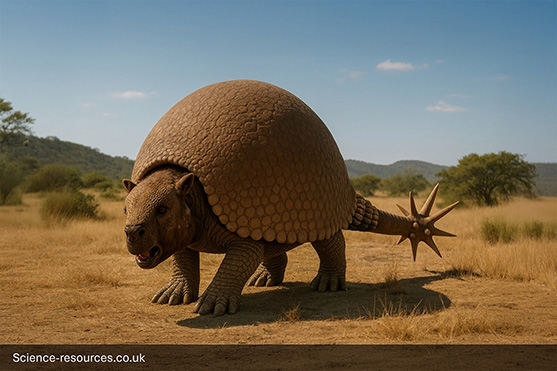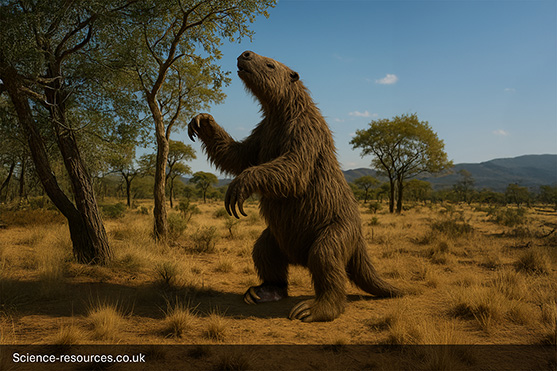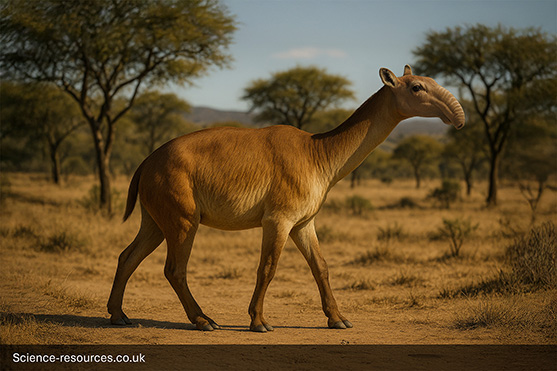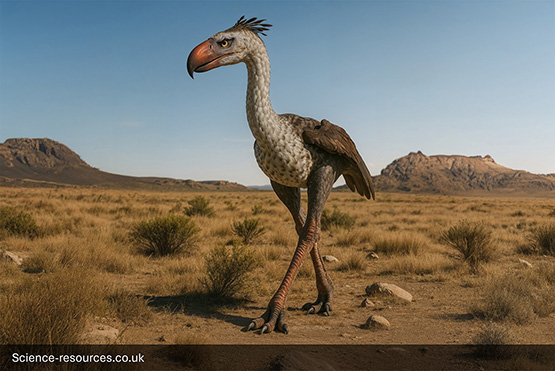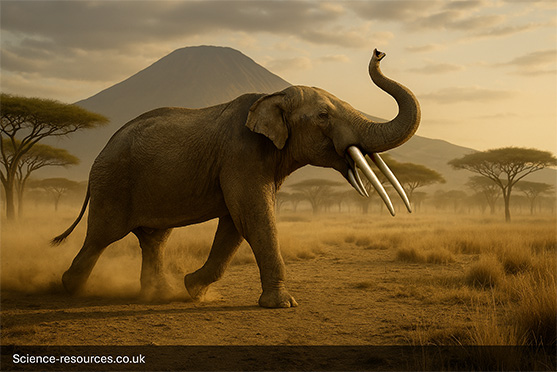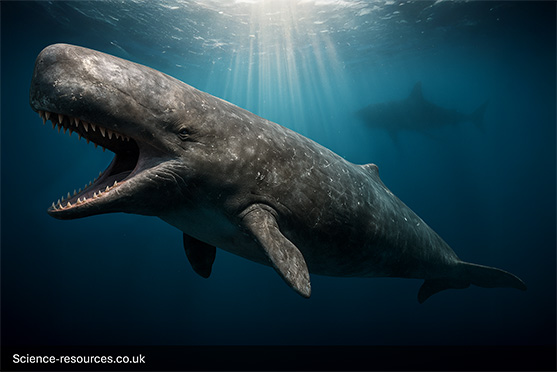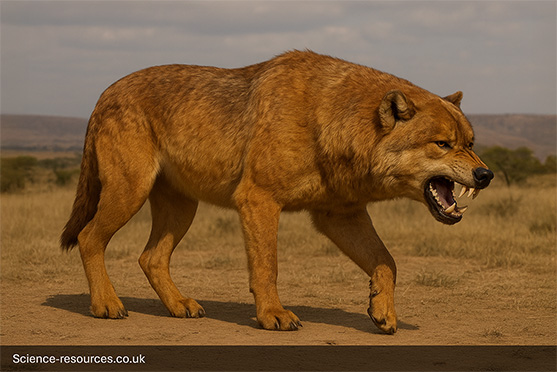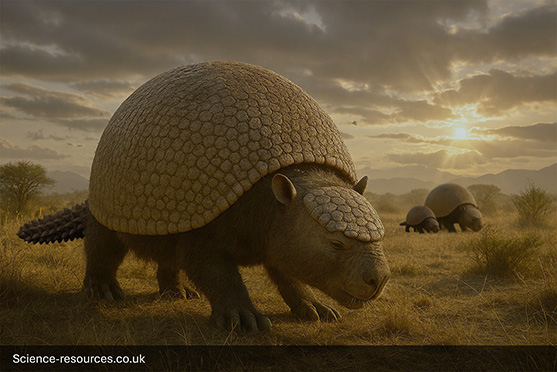Last updated: 4th August 2025
Where They Lived: South America
Extinct Animals of South America
For millions of years, South America was a continent-island, completely isolated from other landmasses. This long period of isolation led to the evolution of some of the most unique and bizarre animals on Earth, with many species found nowhere else. It was a world dominated by strange hoofed animals and massive flightless "terror birds" before the formation of the Isthmus of Panama.
The Pliocene Epoch brought a major change when the land bridge to North America formed, leading to the Great American Interchange. While many of South America's endemic species went extinct, others thrived and moved north. This land was home to giant ground sloths like Megatherium, armored animals like Doedicurus, and the peculiar Macrauchenia.
Featured animals from this location:
Doedicurus
Doedicurus was a heavily armored mammal related to armadillos, living in South America during the Ice Age. It had a large, domed shell and a spiked tail used for defense against predators.
Megatherium
Megatherium was a giant ground sloth from South America that lived during the Pleistocene. It had massive claws and a bulky frame, feeding on leaves and possibly standing upright to reach higher branches.
Macrauchenia
Macrauchenia was a long-necked, hoofed mammal from South America, resembling a camel with a short trunk. It lived from the Miocene to the Ice Age and grazed in open grasslands.
Phorusrhacos
Phorusrhacos was a large, flightless bird from South America, known as a “terror bird.” It had a strong beak and long legs, making it a fast and deadly predator during the Miocene.
Gomphothere
Gomphothere was a large, elephant-like mammal that roamed the Americas during the Ice Age. It had a long trunk and distinctive tusks, which it used to dig for roots and strip bark from trees. Unlike modern elephants, some species had four tusks and a flatter skull, helping them adapt to diverse environments.
Livyatan
Livyatan was a colossal predatory whale from the Miocene epoch, inhabiting oceans around South America. Equipped with enormous teeth and a powerful bite, it rivaled modern sperm whales in size and hunted large marine animals, including other whales, making it one of the top apex predators of its time.
Dire wolf
Dire Wolf was one of the largest canid predators of the Ice Age, roaming North and South America during the Late Pleistocene. With a robust frame, massive skull, and crushing bite force, it was a formidable hunter and likely a dominant pack scavenger in its ecosystem.
Glyptodon
Glyptodon was a massive, armored mammal related to modern armadillos, living in South America during the Pleistocene. Protected by a domed shell and a spiked tail, it was a slow-moving herbivore that grazed on tough vegetation, using its size and defences to deter predators.
You may also be intrested in:
- Extinct Animals: A-Z
- Dinosaurs: A-Z
Tags: Doedicurus, Megatherium, Macrauchenia, Phorusrhacos, South America
© 2012 science-resources.co.uk. All rights reserved | Design by W3layouts
Where They Lived: South America
Extinct Animals of South America
For millions of years, South America was a continent-island, completely isolated from other landmasses. This long period of isolation led to the evolution of some of the most unique and bizarre animals on Earth, with many species found nowhere else. It was a world dominated by strange hoofed animals and massive flightless "terror birds" before the formation of the Isthmus of Panama.
The Pliocene Epoch brought a major change when the land bridge to North America formed, leading to the Great American Interchange. While many of South America's endemic species went extinct, others thrived and moved north. This land was home to giant ground sloths like Megatherium, armored animals like Doedicurus, and the peculiar Macrauchenia.
Featured animals from this location:
Doedicurus
Doedicurus was a heavily armored mammal related to armadillos, living in South America during the Ice Age. It had a large, domed shell and a spiked tail used for defense against predators.
Megatherium
Megatherium was a giant ground sloth from South America that lived during the Pleistocene. It had massive claws and a bulky frame, feeding on leaves and possibly standing upright to reach higher branches.
Macrauchenia
Macrauchenia was a long-necked, hoofed mammal from South America, resembling a camel with a short trunk. It lived from the Miocene to the Ice Age and grazed in open grasslands.
Phorusrhacos
Phorusrhacos was a large, flightless bird from South America, known as a “terror bird.” It had a strong beak and long legs, making it a fast and deadly predator during the Miocene.
Gomphothere
Gomphothere was a large, elephant-like mammal that roamed the Americas during the Ice Age. It had a long trunk and distinctive tusks, which it used to dig for roots and strip bark from trees. Unlike modern elephants, some species had four tusks and a flatter skull, helping them adapt to diverse environments.
Livyatan
Livyatan was a colossal predatory whale from the Miocene epoch, inhabiting oceans around South America. Equipped with enormous teeth and a powerful bite, it rivaled modern sperm whales in size and hunted large marine animals, including other whales, making it one of the top apex predators of its time.
Dire wolf
Dire Wolf was one of the largest canid predators of the Ice Age, roaming North and South America during the Late Pleistocene. With a robust frame, massive skull, and crushing bite force, it was a formidable hunter and likely a dominant pack scavenger in its ecosystem.
Glyptodon
Glyptodon was a massive, armored mammal related to modern armadillos, living in South America during the Pleistocene. Protected by a domed shell and a spiked tail, it was a slow-moving herbivore that grazed on tough vegetation, using its size and defences to deter predators.
Tags: Doedicurus, Megatherium, Macrauchenia, Phorusrhacos, South America
© 2012 science-resources.co.uk. All rights reserved | Design by W3layouts
